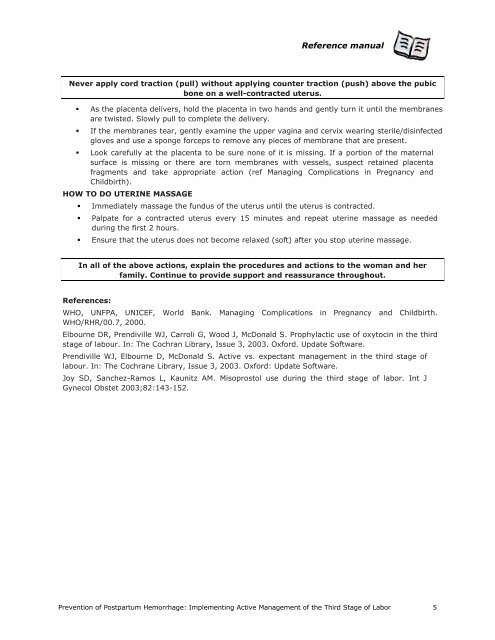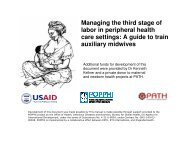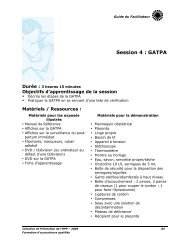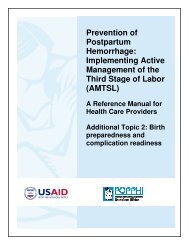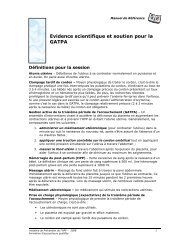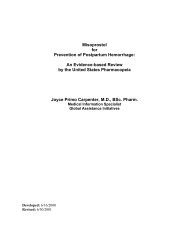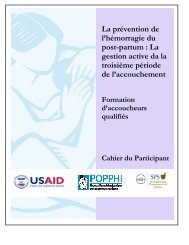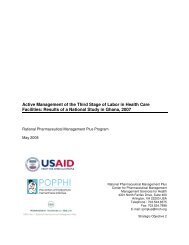Implementing Active Management of the Third Stage of Labor
Implementing Active Management of the Third Stage of Labor
Implementing Active Management of the Third Stage of Labor
You also want an ePaper? Increase the reach of your titles
YUMPU automatically turns print PDFs into web optimized ePapers that Google loves.
Reference manual<br />
Never apply cord traction (pull) without applying counter traction (push) above <strong>the</strong> pubic<br />
bone on a well-contracted uterus.<br />
<br />
<br />
<br />
As <strong>the</strong> placenta delivers, hold <strong>the</strong> placenta in two hands and gently turn it until <strong>the</strong> membranes<br />
are twisted. Slowly pull to complete <strong>the</strong> delivery.<br />
If <strong>the</strong> membranes tear, gently examine <strong>the</strong> upper vagina and cervix wearing sterile/disinfected<br />
gloves and use a sponge forceps to remove any pieces <strong>of</strong> membrane that are present.<br />
Look carefully at <strong>the</strong> placenta to be sure none <strong>of</strong> it is missing. If a portion <strong>of</strong> <strong>the</strong> maternal<br />
surface is missing or <strong>the</strong>re are torn membranes with vessels, suspect retained placenta<br />
fragments and take appropriate action (ref Managing Complications in Pregnancy and<br />
Childbirth).<br />
HOW TO DO UTERINE MASSAGE<br />
<br />
<br />
<br />
Immediately massage <strong>the</strong> fundus <strong>of</strong> <strong>the</strong> uterus until <strong>the</strong> uterus is contracted.<br />
Palpate for a contracted uterus every 15 minutes and repeat uterine massage as needed<br />
during <strong>the</strong> first 2 hours.<br />
Ensure that <strong>the</strong> uterus does not become relaxed (s<strong>of</strong>t) after you stop uterine massage.<br />
In all <strong>of</strong> <strong>the</strong> above actions, explain <strong>the</strong> procedures and actions to <strong>the</strong> woman and her<br />
family. Continue to provide support and reassurance throughout.<br />
References:<br />
WHO, UNFPA, UNICEF, World Bank. Managing Complications in Pregnancy and Childbirth.<br />
WHO/RHR/00.7, 2000.<br />
Elbourne DR, Prendiville WJ, Carroli G, Wood J, McDonald S. Prophylactic use <strong>of</strong> oxytocin in <strong>the</strong> third<br />
stage <strong>of</strong> labour. In: The Cochran Library, Issue 3, 2003. Oxford. Update S<strong>of</strong>tware.<br />
Prendiville WJ, Elbourne D, McDonald S. <strong>Active</strong> vs. expectant management in <strong>the</strong> third stage <strong>of</strong><br />
labour. In: The Cochrane Library, Issue 3, 2003. Oxford: Update S<strong>of</strong>tware.<br />
Joy SD, Sanchez-Ramos L, Kaunitz AM. Misoprostol use during <strong>the</strong> third stage <strong>of</strong> labor. Int J<br />
Gynecol Obstet 2003;82:143-152.<br />
Prevention <strong>of</strong> Postpartum Hemorrhage: <strong>Implementing</strong> <strong>Active</strong> <strong>Management</strong> <strong>of</strong> <strong>the</strong> <strong>Third</strong> <strong>Stage</strong> <strong>of</strong> <strong>Labor</strong> 5


